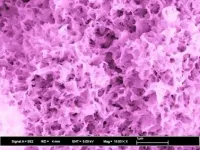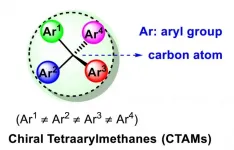(Press-News.org) Reforestation could help to combat climate change, but whether and where to plant trees is a complex choice with many conflicting factors. To combat this problem, researchers reporting in the journal One Earth on December 18 have created the Reforestation Hub, an interactive map of reforestation opportunity in the United States. The tool will help foresters, legislators, and natural resource agency staff weigh the options while developing strategies to restore lost forests.
"Often the information we need to make informed decisions about where to deploy reforestation already exists, it's just scattered across a lot of different locations," says author Susan Cook-Patton, a Senior Forest Restoration Scientist at the Nature Conservancy. "Not everybody has the computer science experience to delve into the raw data, so we tried to bring this information together to develop a menu of options for reforestation, allowing people to choose what they would like to see in their community, state, or nation."
The culmination of these efforts is the Reforestation Hub, a web-based interactive map that color-codes individual counties by reforestation opportunity or level of potential for successful reforestation. And the results show that there is a great deal of reforestation opportunity in the United States.
"There are up to 51.6 million hectares (about 200,000 square miles) of opportunity to restore forest across the United States after excluding productive cropland and other places where trees are infeasible," she says. "Those additional forested areas could absorb the emissions equivalent to all the personal vehicles in California, Texas, and New York combined."
In addition to quantifying the amount of land that could yield viable forests, the Hub also identifies trends in how this opportunity is distributed throughout the country.
"While there's no single best place to restore forest cover, we did find a particularly high density of opportunity in the Southeastern United States," says Cook-Patton. "This is a region where carbon accumulation rates are high, costs are low, and there is a lot of opportunity to achieve multiple benefits like creating habitats for biodiversity, improving water quality, and climate mitigation."
The map also quantifies the acreage of 10 individual opportunity classes--or categories based on land ownership and quality. Some of these include pastures, post-burn lands, and floodplains. "The choice to plant trees really depends on what people want out of the landscape, whether it's controlling flood waters, improving urban environments, or recovering forests after a fire," she says.
The researchers hope to create similar maps for other countries, an important next step for combating the global problem of climate change.
"We have about a decade to get climate change in check," Cook-Patton says, "and I am excited about the potential for this study to help accelerate decisions to invest in reforestation as a climate solution."
INFORMATION:
The research was supported by the Doris Duke Charitable Foundation and the Rodney Johnson and Katharine Ordway Stewardship Endowment. The Reforestation Hub was created with support from American Forests and the Sant Foundation.
The Reforestation Hub can be found at https://www.reforestationhub.org/
One Earth, Cook-Patton et al.: "Lower cost and more feasible options to restore forest cover in the contiguous United States for climate mitigation" https://www.cell.com/one-earth/fulltext/S2590-3322(20)30603-5?utm_source=EA
One Earth (@OneEarth_CP), published by Cell Press, is a monthly journal that features papers from the fields of natural, social, and applied sciences. One Earth is the home for high-quality research that seeks to understand and address today's environmental Grand Challenges, publishing across the spectrum of environmental change and sustainability science. A sister journal to Cell, Chem, and Joule, One Earth aspires to break down barriers between disciplines and stimulate the cross-pollination of ideas with a platform that unites communities, fosters dialogue, and encourages transformative research. Visit http://www.cell.com/one-earth. To receive Cell Press media alerts, contact press@cell.com.
The impact of the COVID-19 pandemic on public health is staggering; more than one hundred million cases and two million deaths worldwide. In response, most countries and local governments have taken substantial measures -- such as travel restrictions and physical distancing -- to keep their citizens safe. Both the pandemic and related protective measures pose challenges for ongoing clinical research studies seeking to treat and prevent the world's greatest public health emergencies including COVID-19, but also Alzheimer's disease and other dementia.
In a new paper from the World-Wide FINGERS network in Alzheimer's ...
DALLAS, March 11, 2021 -- As integral members of stroke treatment teams, nurses coordinate patient assessment and collaborate care among multiple health care professionals to facilitate the best possible outcomes for patients with acute ischemic stroke. Nurses also advocate for patients and their caregivers to ensure they receive appropriate information and education to successfully navigate phases of treatment in the hospital and after discharge. A series of three new Scientific Statements, "Care of the Patient With Acute Ischemic Stroke," from the American Heart Association, published today in Stroke, a journal of the American Stroke Association, a division of the American Heart Association, provide the latest evidence-based guidance ...
Results published today show it is possible to identify Parkinson's based on compounds found on the surface of skin. The findings offer hope that a pioneering new test could be developed to diagnose the degenerative condition through a simple and painless skin swab.
Scientists at The University of Manchester have developed a technique which works by analysing compounds found in sebum - the oily substance that coats and protects the skin - and identifying changes in people with Parkinson's Disease. Sebum is rich in lipid-like molecules and is one of the lesser studied biological fluids in the diagnosis of the ...
An interdisciplinary research team at Lehigh University has unraveled how functional biomaterials rely upon an interfacial protein layer to transmit signals to living cells concerning their adhesion, proliferation and overall development.
According to an article published today in Scientific Reports, the nanoscale features and properties of an underlying substrate do not impact the biological response of cells directly. However, these properties indirectly influence cell behavior through their control over adsorbed proteins.
In the article, "Nanostructure ...
Firefly beetles rank among the world's most charismatic creatures, with luminous courtship displays that have now turned them into a popular attraction for wildlife tourists. In the first comprehensive review of firefly tourism, published in the journal Conservation Science and Practice, an international team of biologists led by a Tufts University researcher, reveal that an estimated 1 million people now travel each year to witness bioluminescent performances starring some two dozen firefly species around the world.
But the authors also point out that while this unique, insect-based tourism ...
An eight-week programme of mindfulness meditation improves quality of life and reduces fear of activity in heart attack patients, according to research presented today at ESC Acute CardioVascular Care 2021, an online scientific congress of the European Society of Cardiology (ESC).1
"A heart attack is a serious life-threatening event and survivors can suffer from low quality of life," said study author Dr. Canan Karadas of Hacettepe University, Ankara, Turkey. "One reason is a fear of movement, called kinesiophobia, which limits daily activity due to concerns of another heart attack."
"Mindfulness refers to the mental state achieved by focusing awareness on the present moment, ...
The research was published on the journal Nature Catalysis on December 14, 2020.
A strong bias towards linear and disc-shaped molecules has long been observed in drug molecules. In contrast, spherical molecules have been utilized on far fewer occasions, due to the lack of efficient access to the latter chemical space. Specifically, efficient strategies to synthesize tetraarylmethanes, a unique family of spherical molecules, have remained scarce.
Chiral tetraarylmethanes (CTAMs), a unique family of spherical molecules which bear four different aryl groups with defined stereochemistry, remain as a mystery due to the lack of efficient asymmetric synthesis. The challenge in asymmetric synthesis of CTAMs lies in not only the high barrier in making ...
Giving at scale by the super-wealthy has done little to redistribute wealth from rich to poor, helping perpetuate social inequalities rather than remedying them, while paying considerable dividends to donors in the form of privilege and influence in society and politics, new research shows.
In the research paper 'Elite philanthropy in the United States and the United Kingdom in the new age of inequalities' researchers at the University of Bath School of Management and Newcastle University Business School also conclude that giving by the super-wealthy has failed significantly to benefit poor countries in the developing ...
Pregnant women remain at increased risk of severe COVID-19, and their risk of being admitted to intensive care or needing invasive ventilation is higher than non-pregnant reproductive aged women with the virus, an ongoing global study has found.
Pregnant women with COVID-19 are at increased risk of severe COVID-19, particularly if they are from ethnic minority backgrounds, or if they have pre-existing conditions like obesity, high blood pressure and diabetes, concludes the research led by the University of Birmingham and World Health Organization (WHO).
Their research, ...
New research indicates that lockdowns to help tackle the spread of COVID-19 could be linked to an increase in symptoms associated with eating disorders.
The longitudinal study, carried out by academics from Anglia Ruskin University (ARU) in Cambridge, England, and published in the journal Psychiatry Research, examined the behaviour and attitudes of 319 health club members during the summer of 2020.
The researchers followed up initial research into addictive or unhealthy behaviours, conducted in 2019, to investigate the effects of the first COVID-19 restrictions introduced in the spring of 2020.
Participants, with an average age of 37, completed the eating attitudes test, called EAT-26, which involved answering questions related to statements ...



